Christmas in Poland
| Christmas in Poland | |
|---|---|
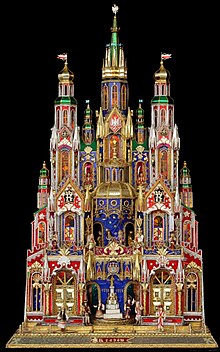
|
|
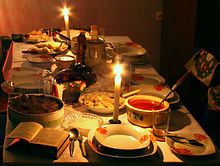
Christmas Eve Supper
|
|
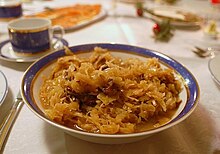
Traditional Christmas Day dinner serving of bigos on December 25
|
|

Christmas desserts
|
|

Nativity scene at the Catholic Church of Christ the King in Sanok
|
|
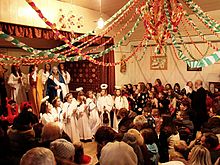
Nativity play (Jasełka or Herody) by children
|
|
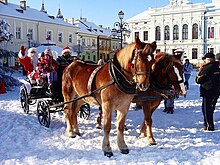
Kulig with Santa
|
Christmas in Poland is a major annual celebration, as in most countries of the Christian world. The observance of Christmas developed gradually over the centuries, beginning in ancient times; combining old pagan customs with the religious ones introduced after the Christianization of Poland by the Catholic Church. Later influences include mutual permeating of local traditions and various folk cultures. Christmas trees are decorated and lit in family rooms on the day of Christmas Eve. Other trees are placed in most public areas and outside churches. Christmas is called "Boże Narodzenie" in Polish (literally 'God's Birth').
Among the special tasks carried out in private homes during Advent (a time of waiting for the celebration of the Nativity of Jesus) is the baking of the Christmas piernik (gingerbread), and the making of Christmas decorations. Pierniki (plural of piernik) are made in a variety of shapes, including hearts, animals, and St. Nicholas figures. St. Nicholas does not play a major role on Christmas Day, but is celebrated on his Saint feast day of December 6. He visits good children in secret and leaves presents for them.
Traditionally, the Christmas trees are decorated with glass baubles, garlands and many homemade ornaments including painted eggshells, shiny red apples, walnuts, wrapped chocolate shapes, candles, etc. They are lit on Christmas Eve before Wigilia. At the top of each tree there is a star or a glittering tree topper. In many homes, sparklers are hung on the branches of the trees for wintery ambiance. Sometimes the trees are left standing until February 2, the feast day of St. Mary of the Candle of Lighting.
...
Wikipedia
